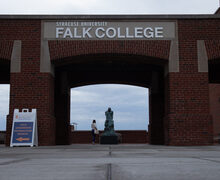Students learn better with peer-to-peer models of learning, study finds
Courtesy of Stephen Sartori
Julia Snyder, a research assistant professor in SU's Department of Biology, was the first person to introduce peer-to-peer learning to the department.
A recent study by Syracuse University professors and students found that more academic success may correlate with an alternative learning model.
Julia Snyder, a research assistant professor in the Department of Biology, co-authored a study published in the journal PLOS Biology that found that students performed significantly better when they engaged in peer-led team learning. Other co-authors included Jeremy Sloane and Ryan Dunk, biology graduate students; and Jason Wiles, an associate professor of biology.
Snyder first introduced the concept of peer-to-peer learning to the Department of Biology at Syracuse University in 2011.
The model of peer-to-peer learning already existed when Snyder was completing her Ph.D. at SU, but she was the first to implement the program to the biology department.
The idea of peer-to-peer learning is to supplement a lecture, said Sloane, adding that it’s essentially a weekly workshop where a peer leader who has taken the course comes back and helps students with the work.
Snyder received a grant in 2014 that enabled her to continue her work with peer-to-peer learning and this is the final semester of the grant allowing her to do her work. If the program does not receive more grant money, Sloane will take over the program, Snyder said.
Sloane said the longer students participated in the peer-to-peer program, the more improvement they showed.
“One interesting thing that was found is that minority students at Syracuse under this program did significantly better,” Sloane said.
Sloane added that most students — not just minority students — benefited from the program.
At SU, Sloane said it is becoming more acknowledged that big lectures are not the only way that students can learn.
“We’ve seen such promising results and would like to keep (the peer-to-peer learning program) running,” Snyder said.
Now that the model has been put in place Snyder said she believes that it is possible to be implemented in class regardless of funding.
“As long as there is someone in the education field who can work with the leaders, who are teaching the sessions,” she added.
Snyder said the most recent research on peer-to-peer learning has been focused on minority groups. She said the research found there was a “drastic” reduction in minority students who received Ds and Fs. There was also a higher retention of minority students in science, technology, engineering and math courses, she added.
“There has been a lot of data that has shown active learning methods are better and superior for students,” Snyder said. “Students achieve much better when they have active learning.”
Unfortunately, she said, lecture is still the most used.
She added that it is “pretty challenging” to have these large lectures switched to smaller active learning.
“There will be a lot of challenges, but it is possible and worth overcoming because it will help students to achieve at a higher level,” Snyder said.
Snyder said she would hope to see this model move forward in the biology department.
“Once we have gotten it through the department I would hope it could move to other departments because this model can be used across many different disciplines,” Snyder said.
Published on March 29, 2016 at 8:03 pm
Contact Connor: [email protected]




